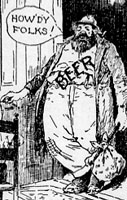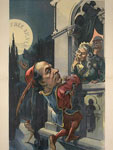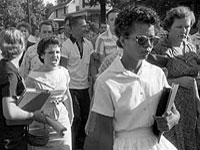Living History At Lincoln's Summer Retreat
NPR describes Abraham Lincoln's relationship with his summer cottage, right outside of Washington, DC.
(To learn more about the cottage, check out NHEC's entry on the historical site.)
NPR describes Abraham Lincoln's relationship with his summer cottage, right outside of Washington, DC.
(To learn more about the cottage, check out NHEC's entry on the historical site.)
In commemoration of the bicentennial of the 16th president's birth, the National Gallery of Art in Washington, DC, has rolled out a special exhibition called "Designing the Lincoln Memorial: Daniel Chester French and Henry Bacon," which will be on view for the rest of this year. NPR's Susan Stamberg looks at the creation of the monument which has presided over so many public events and gatherings since it was dedicated in 1922.
Ronald C. White Jr. discusses his new biography, A. Lincoln, and examines Lincoln as a man, beyond his role and time as President, focusing on Lincoln's humility.
To celebrate Presidents Day, NPR classical music commentator Miles Hoffman explores the 16th president's musical tastes, as well as what music Lincoln might have chosen for his iPod, had he owned one.

This small, but useful, website offers a wide range of primary source material for researching the history of the prohibition movement, temperance, and alcoholism. The more than 1,800 items include broadsides, sheet music, pamphlets, and government publications related to the temperance movement and prohibition.
Materials come from the period leading up to prohibition, such as an 1830s broadside on the "Absent Father" as well as the prohibition era itself, such as a 1920 pamphlet entitled, "Alcohol Sides with Germ Enemies." They end with the passage of the 21st Amendment in 1933.
All digitized items are in the public domain. An essay, "Temperance and Prohibition Era Propaganda: A Study in Rhetoric" by Leah Rae Berk provides an overview of the topic and historical context.

Why were the people living in rural areas more likely to support "free silver" in 1896 than urban dwellers?
Political battles over currency issues became intensely divisive during the last quarter of the 19th century as industrialization accelerated in the Northeast, while the South and newly settled areas of the Midwest remained dependent on farming. From 1873 through the late 1890s, the U.S. suffered through two major economic depressions that heightened sectional and class conflict. By the 1896 election, designated by historian Walter Dean Burnham as “the first confrontation . . . among organized political forces over industrial capitalism,” positions on currency had solidified into a “battle of the standards.” “Gold bugs” believed that a “sound” national economy must be based on the gold standard to ensure the dollar’s stability, guarantee unrestricted competition in the marketplace, and promote economic liberty. “Silverites” believed that currency should be redeemable in silver as well as gold. They agitated for “free silver,” or unlimited coinage of silver, a metal that could be mined in abundance in the West, to produce an increased and more flexible money supply that they hoped would lead to a more equitable economy and foster social reforms.
Congress had discontinued the minting of silver coins in 1873 in an act that came to be known as the “Crime of ’73.” Professor of government Elizabeth Sanders includes the demonetization of silver as one of a few significant policies of the period that led many working people, especially farmers, to believe that a “fraud against the people” was being “perpetrated by the national state on behalf of a financial elite.” With silver coins delegitimized, the amount of money in circulation decreased. A tightened money supply benefited creditors, like banks and merchants, at the expense of debtors, especially farmers who had to borrow annually from banks and merchants in order to plant cash crops that could bring in money for the repayment of their debts only at harvest time. Farmers sought inflation of the money supply so that more money would be available to them for credit, prices for their crops would rise, and debts would become easier to repay.
Advocates for inflating the money supply ranged from those who proposed that the federal government print paper money not backed by either gold or silver to those who called for the remonetization of silver. Free silver proponents came to believe in the 1890s that unlimited coinage of silver, a reform less extreme than others that agrarian radicals earlier had supported, could unite divergent groups into a national coalition to challenge politicians who supported monied interests.
The People’s Party, also known as the Populists, formed as a political party in 1891. As Sanders emphasizes, “Its philosophy was anti-corporate, though not anti-capitalist.” The Populist platform during the 1892 election campaign advocated free silver and other reforms with the intent, Sanders writes, “not to turn the clock back on industrial development but to harness the new technological power for social good, to use the state to check exploitative excesses, to uphold the rights and opportunities of labor (farm and factory), and to maintain a healthy and creative business competition.”
Populists hoped to win the 1896 election and supplant the Democrats as one of the nation’s two major national parties. Their strategy relied on convincing silverites from the Democratic Party to vote with the Populists rather than for the expected Democratic nominee, President Grover Cleveland, who supported the gold standard, as did the Republican nominee, Ohio governor William McKinley. The Democrats, however, selected as their candidate William Jennings Bryan, a strong advocate for free silver. McKinley forces, mounting a well-funded campaign supported by the Northern intelligentsia, church and business interests, and the urban press, tarnished Bryan as a radical with an economic program that would lead to disastrous consequences for the nation. McKinley soundly won the election, and although Bryan triumphed in 22 states to McKinley’s 23, McKinley captured nearly 100 more electoral votes and prevailed in every city of more than 100,000, with the exception of Denver, where the silver mining interest was strong.
Some historians believe that many urban workers voted for McKinley because they had become convinced that Bryan’s policies would destroy the economy and result in reduced wages and increased unemployment. Some argue that Bryan’s “revivalist” style of campaigning and the Prohibitionist views of some of his supporters were distasteful to Catholics, especially Germans, in the urban labor force. Sanders contends that reporters’ coverage of Bryan’s campaign provides strong evidence that his message, in fact, did resonate with urban workers. She suggests, however, that “the powerful economic warnings of the core establishment” and the claim that a program to benefit farmers would wreck havoc upon the Northern industrial economy “were ultimately persuasive on election day.”
Sanders and others emphasize that labor organizations of the time did not want to rely on government to resolve its disputes with management. Unions sought to effect change through exerting leverage at the work site itself. Burnham writes, “From the perspective of the urban voter committed to the network of urban-industrial social and economic relationships that now existed, currency inflation could only be regarded as irrelevant at best and disruptive at worst.”
Burnham, Walter Dean. “The System of 1896: An Analysis.” In The Evolution of American Electoral Systems, by Paul Kleppner, et. al. Westport, CT: Greenwood Press, 1981.
Kazin, Michael. A Godly Hero: The Life of William Jennings Bryan. New York: Alfred A. Knopf, 2006.
Postel, Charles. The Populist Vision. New York: Oxford University Press, 2007.
Ritter, Gretchen. Goldbugs and Greenbacks: The Antimonopoly Tradition and the Politics of Finance in America. New York: Cambridge University Press, 1997.
Sanders, Elizabeth. Roots of Reform: Farmers, Workers, and the American State, 1877-1917. Chicago: University of Chicago Press, 1999.
Weinstein, Allen. Prelude to Populism: Origins of the Silver Issue, 1867-1878. New Haven: Yale University Press, 1970.
Video background from The Library of Congress Webcasts site:
"From Benjamin Franklin's drawing of the first American political cartoon in 1754 to Herblock's blistering attacks on Richard Nixon, editorial cartoons have always been a part of American journalism and politics. The authors of "American Political Cartoons 1754-2010" discuss their book."

This site furnishes hundreds of links to primary and secondary sources on North American history. An eclectic collection, it includes links to library catalogs throughout the world, archival collections, texts, journals, discussion lists, bibliographies, encyclopedias, maps, statistics, book reviews, biographies, curricula, and syllabi. Materials are arranged by subject, period, and document type. Try "History-North America" for the widest variety of vetted sources. Special resource collections include "America in the 1950s," "New Americans: American Immigration History," "The Newark Experience," "U.S. Business History," "U.S. Labor and Working Class History," and "Videos on the U.S. and American Studies."

This collection of newspaper articles and photographs from two Arkansas newspapers explores the 1957 crisis in the city of Little Rock. National attention focused on the city when Governor Orval Faubus refused to allow nine African American students to desegregate the city's all-white Central High School, despite federal court rulings to the contrary. In response, President Dwight D. Eisenhower reluctantly became the first president since Reconstruction to send federal troops to protect the rights of African Americans.
Materials include news articles and editorials from each day of the month-long crisis, articles on the anniversaries from 1997 to 2000, and 16 photographs. In addition, material on the 40th anniversary of the crisis is provided: 19 op-ed pieces, speeches, an interview with President Clinton, timelines, and a 1991 defense by Faubus of his actions.

This site is a compilation of the unpublished papers of founding father John Jay, dating from 1745 to 1829. It is comprised of nearly 14,000 pages scanned from Jay's manuscripts and related materials. Abstracts and bibliographic notes accompany the scanned images. The primary documents are difficult to read in the original handwriting and they have not yet been transcribed. The quality of some of the images is also poor, although users can enlarge and enhance them. The records are searchable by name of writer, date of composition, name of holding institution, and accession number. Keyword searching of the abstracts, which vary in length and informational detail, is also possible.
Users will find letters from such prominent individuals as John Adams, Benjamin Franklin, Alexander Hamilton, Thomas Jefferson, and George Washington. The correspondence deals with New York, anti-slavery, repeal of the Missouri Compromise, international affairs, and state government and politics. Those unfamiliar with Jay and his historical significance should be sure to visit the site's four thematic pages, each containing an essay (500 to 800 words) with links to documents. The site also includes a 1,300-word brief biography and a more than 50 item bibliography of relevant sources.